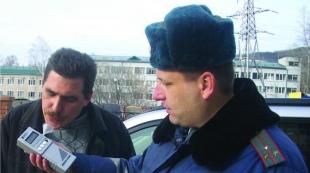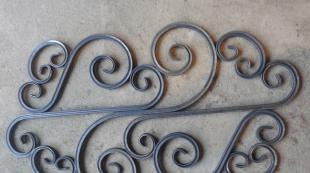What is the resistance of a 220 volt soldering iron. Do-it-yourself ceramic heating element for a soldering iron
Let me remind you that we have in our hands a soldering iron with a torn power cord. Tasks for the next half an hour:
A) familiarize yourself with internal structure review hero;
b) if possible, bring him back to life.
The first thing we do is remove the heat-resistant plastic handle. In the hands remains - let's call it that - "casing", which actually housed all the insides of the patient.
We unscrew the only bolt - two or three turns allow you to fix or release the rod, which is actually used for soldering, and completely separating it from the thread allows you to remove the "cartridge" for the rod.

On the other side of the "casing" we bend two antennae and carefully take out first two thin tubes about 4 cm long, metallic in color, and behind them - the heating element itself - the same type of tube of larger diameter and length, in which a metal spiral with high resistivity (most likely nichrome).


As you can see, the contacts of our helix remained intact - great news. To verify the integrity of the heating element, you can measure the resistance between the contacts. For a 25W soldering iron, it resists approximately 2kΩ +/-100Ω.
Here is everything that any standard soldering iron consists of:

The next step is to connect the contacts of the spiral to the power cord. Do not forget that you first need to “put on” the soldering iron handle and a white heat shrink tube on the cord, and small tubes on each wire that serve to isolate one contact from another

(although they look like metal, in fact they do not conduct current, they easily crumble, peel off. In addition, they are not afraid of high temperatures).

You can cheat - tie the wires somehow, but in this case it is possible that the patient will soon fall ill again, so we'd better overdo it.

It turns out? Then everything is millet - we put on our insulating tubes on the bare wire, slip a white PVC heat-shrink tube closer, and put the whole thing in the "casing" of the heating element.

Since the rod holder and the rod itself were pretty smoked during operation, I advise them to be slightly cleaned with fine emery, and the “cartridge” should be additionally flattened lightly - to achieve better contact and heat transfer from one to another.

We place the cartridge with the rod in the “casing” on the other side, and fix it with a screw.

Just in case, we check the resistance again, this time between the contacts of the power plug. It should not have changed, so if it increased, it means that somewhere you have a bad contact. If the resistance is close to zero, you managed to make a short circuit somewhere in this simple circuit. Neither the first option nor the second, of course, are suitable for any real tests and, moreover, work. We disassemble the soldering iron again, correct the errors, assemble in the reverse order.
Is everything okay now? Well, then you can bend the antennae of the "casing" of the heating element ...

... and put a plastic handle on it.
Just in case, we will also check the resistance between the contacts of the power plug. Now the soldering iron can be connected to the network with a confident hand. Particularly shy, you can hide behind the sofa, and turn on the soldering iron through a network extension cord or even a knife switch in the corridor :).
Everything _should_ work.
Personally, I succeeded. The whole thing took about half an hour. For the whole day I received a boost of energy from a craftsman - you can move to new heights!
Have you purchased a soldering iron, but the quality of its work is not satisfactory? Then you will find material in this article on how to repair a soldering iron if you do not want to take it to the workshop, but decide to do it yourself. In the presented video tutorial, we are talking about a cheap Chinese device in which some parts need to be replaced.
Unusual soldering irons are sold cheaply in a Chinese online store.
First look at what you need to remake the soldering iron:
- soldering iron;
- thick copper wire;
- screwdriver;
- drill;
- the wire;
- wire cutters;
- electrical tape;
- fork;
- flux;
- tin;
- metal sponge.
The first thing we pay attention to is the inefficient soldering iron tip. we will replace it with a copper wire of the desired diameter. We take out the old sting and make it out of copper in the same size (thickness and length).
It remains only to tin the sting and you can solder with a normal soldering apparatus that you have modified.
Notes. Another disease of Chinese soldering irons is severe overheating during operation. It is eliminated by including a diode with an operating voltage of at least 300 volts into the gap (it can be mounted in a mains plug, the polarity of the connection does not matter). In order for the soldering iron tip to burn less, it must be cold forged with a small hammer before work, while the copper is compacted and does not burn so quickly.
DISASSEMBLY AND REWINDING THE SOLDERING IRON
If you, fellow hobbyist, have already “outgrown9raquo; soldering iron with voltage regulator. but has not yet “grown up” in its ambitions to a professional soldering station. then it might be interesting. The ability to change the supply voltage of a soldering iron designed for 220 V, among other things, allows you to return an already burned out one to operation. And use it in the future, for example, with a switching power supply from an imported TV, which at the output gives exactly half of the network. Bringing these two products together results in an intermediate option between a soldering iron with a regulator and a full-fledged soldering station. This is within the power of any radio amateur. I will show how to do this using the example of changing the supply voltage of a Chinese-made soldering iron, which did not inspire confidence for use without modification.
We disassemble the soldering iron

To disassemble the soldering iron, it was necessary to completely unscrew the two screws connecting the protective casing to the heating element and holding the tip, and three self-tapping screws securing the working part to the handle. Move the insulation from the wires and unwind the connecting twists.

Mica with soldering iron spiral
Inside the protective casing is a heating element. They are to be dealt with. It is necessary to make a change in the amount of wound nichrome wire - change the resistance of the heating element. Now it is 1800 ohms, 400 ohms are needed. Why exactly so many? Currently working with a UPS, the soldering iron has a resistance of 347 Ohms, its power is from 19 to 28 W, the second there is a desire to make it less powerful, so Ohm was added.
Rewind soldering iron

Winding the tip of the soldering iron
The sting is inserted into the heater again, clamped with screws and into the drill chuck. If you disassemble and unwind excess nichrome while holding the heating element in your hands, then everything will be much more complicated. The binding wire is removed.

The released wrappers of fiberglass and mica are removed. There is a slot in the mica from the side of the sting, where the conductor is inserted, going from nichrome to the network wire - therefore, the weakened mica wrapper is not unwound, but removed from it. Mica is a very brittle material. The end of the nichrome wire attached to the conductor is disconnected. Its thickness is just over 4 microns.

Nichrome must be wound on something round, the ideal option is a spool of thread. Unscrewed - rewound and so on until the end. It is not necessary to disconnect the second end of the nichrome wire.

Soldering iron wire resistance
Now you need to wind a length of 400 ohms, and in centimeters it will be about 70 (the total length of the nichrome wire of 300 cm is 1800 ohms, hence 400 ohms will be 66.66 cm). A latch (clothespin) is placed on a length of 70 cm and in the hanging position of the coil, slightly guiding with your fingers, winding is performed with an interval that ensures its termination at the first conductor. The rate of attempts is not limited, the main thing is not to break the nichrome. At the end of the winding, a control measurement of the resistance is necessary.

As soon as it turned out to wind the required amount of nichrome, cut off the wire with an allowance of 1 - 2 cm and attach it to the conductor. We put on the mica winding, passing the conductor into the slot in it and pressing it against it (of course, on top of it).

From above we install a fiberglass winding and seal it by pressing, we wind the tie wire. The heating element designed for power supply with a voltage of 85 - 106 V is assembled.
Soldering iron assembly

Since the working part was previously attached to the handle with unintelligibly clumsy and short self-tapping screws, they had to be replaced. To do this, holes for new self-tapping screws were deepened at the attachment points on the handle.

Before connecting the mains wire to the conductors going to the nichrome heater, a plastic clamp was installed and adjusted on it.

The casing of the heating element ends with a kind of cooling radiator, through the holes in it and is attached to the handle. Here, to increase the cooling effect, the gap between it and the handle was increased using metal washers.

Soldering iron current consumption 190 mA
The UPS with which the soldering iron will work at the output under load gives from 85 to 106 V. The current consumption is 190 mA, this is at a minimum voltage. Power 16 W.

Soldering iron current consumption 240 mA
At maximum voltage, the current consumption is 260 mA. Power 26 W. Wish received.

In conclusion, the test for the duration of heating. Up to 257 degrees in 2 minutes 20 seconds. An excellent result, if we take into account that from a network with a voltage of 225 V, it heated up to 250 degrees in 5 and a half minutes.

Table. The dependence of the resistance of the heating element on the power and voltage of the soldering iron
And here is a table that will help you navigate the required resistance of the heating element, depending on the desired power and the available supply voltage. The author is Babay from Barnaula.
Fetishism sin many. Everyone has their own object of adoration. I would venture to suggest that for radio amateurs this is most often a soldering iron. So I had one, until I decided to make an improvement - I put a diode in the wire break and a toggle switch to it. Well, everyone knows this rationalization for a long time. Convenient, I liked it. That's just the soldering iron burned out. Already in a month. Clearly a coincidence. Repaired - fastened (compressed) the ends at the burnout site with a piece of copper plate. And a month later again. The second plate did not fit in the heating element. A year has passed. And here, extracting from the board of an imported TV impulse block power supply, I figured out how to give a second life to a faithful partner - if there is not enough length of a whole nichrome wire (and where can I get it with a diameter of 0.08 mm?) To wind the heating element at a voltage of 220V, then this can be done at a lower voltage, for example 110V, from the available "scraps9raquo; (nichrome after all need less).

To begin with, I made measurements and calculations. I measured the resistance of an existing whole piece of nichrome - 367 ohms. The output voltage of the power supply, took a value of 110V, divided by 367 Ohms and got the required current - 0.3 A, multiplying which by 110V found out the estimated possible power of the soldering iron - 33W. Quite enough. The existing mandrel with a dielectric (mica) wound on top was placed in a cartridge hand drill, fastened nichrome with one end to a conductor wire, and wound the second on an impromptu bobbin, attached clothespins for weight.


It's not ideal, though. The main thing here is that the coils do not touch each other. The second end of nichrome to the second wire - the conductor. On top of the nichrome again is a dielectric, of course you need mica, but there wasn’t - in the photo there is an asbestos cord.

Conductors (wires) are bent in the right direction, the far one is pressed against the asbestos. Contact between conductors - wires should be EXCLUDED. On top of the dielectric again - mica.

Then everything is simple: we pass the wire coming from the plug through the handle of the soldering iron and the casing, and connect its cores with the help of twisting to the conductors in contact with nichrome, after putting it on the last insulators that were on them before disassembly. We put everything in the casing.

Cover in the handle. Sting inside the mandrel of the heating element.

Now be sure to “ring 9raquo; pins of the power plug relative to the casing and soldering iron tip! CONTACT SHOULD NOT BE.

"Running9raquo; tests were successful. The fact that turning on this soldering iron now into a 220-volt outlet is not worth it, of course, is clear to everyone. And smooth temperature control, if necessary, is assembled according to this scheme. Wishing you success, Babay. Russia, Barnaul.
Repair of a burned-out soldering iron (for soldering parts), do-it-yourself replacement of the heating element.
Topic: what to do if the soldering iron burned out, how to restore it yourself.
 Sometimes a soldering iron, which you use to solder various circuits, parts, wires, suddenly stops working, it does not heat up. In most cases, it can be a simple broken wire that powers the electric soldering iron itself. The most vulnerable point of the wire is the area of frequent bending. For a soldering iron (and not only for it), this is the place where the wire enters the soldering iron itself. You just need to disassemble it and ring the wires coming from the plug. If the wire does not ring, then simply cut off a small piece (about 15 cm long) from the side of the entrance to the soldering iron. Call again. If there is still no contact, then cut off the same piece from the side of the plug. Well, as a last resort, just put a new wire.
Sometimes a soldering iron, which you use to solder various circuits, parts, wires, suddenly stops working, it does not heat up. In most cases, it can be a simple broken wire that powers the electric soldering iron itself. The most vulnerable point of the wire is the area of frequent bending. For a soldering iron (and not only for it), this is the place where the wire enters the soldering iron itself. You just need to disassemble it and ring the wires coming from the plug. If the wire does not ring, then simply cut off a small piece (about 15 cm long) from the side of the entrance to the soldering iron. Call again. If there is still no contact, then cut off the same piece from the side of the plug. Well, as a last resort, just put a new wire.
But not in all cases, the reason why an electric soldering iron does not work is a break in the wire that feeds it. Sometimes the heating element itself burns out inside the soldering iron. Here you can go two ways. You can try to rewind the heating coil yourself. This is a fairly simple task if you have something to rewind and if the soldering iron was designed for a voltage not higher than 36 volts. For a soldering iron supply voltage of 220 volts, rewinding the spiral will be much more difficult. A thin and long wire must be carefully wound (so that the turns do not have direct contact) on the base of the heater. For a beginner, this is difficult and time consuming.
 You can go the other way. Repair of a burnt soldering iron can be reduced to replacing the entire heating element. For example, when the problem of a burned-out soldering iron touched me, I went to the aliexpress website, entered “soldering iron heater” in the search, and then chose the most suitable option(in size, according to the power and supply voltage I need). The cost of this heating element was quite small (compared to buying a new electric soldering iron). Then I placed an order, paid, delivery took about 2 weeks.
You can go the other way. Repair of a burnt soldering iron can be reduced to replacing the entire heating element. For example, when the problem of a burned-out soldering iron touched me, I went to the aliexpress website, entered “soldering iron heater” in the search, and then chose the most suitable option(in size, according to the power and supply voltage I need). The cost of this heating element was quite small (compared to buying a new electric soldering iron). Then I placed an order, paid, delivery took about 2 weeks.
Installing a new heating element on a burned-out soldering iron was not difficult. He normally entered the base of the soldering iron. Unless the old sting was slightly larger than the hole that was on the new heater. I just took a piece of copper wire of the right length and diameter. One of its ends (the one that will be soldered) was ground off at an angle. The heating element is fixed with one short screw, on one side of the soldering iron base. The sting itself is fixed with another screw (slightly longer than the first) on the other side of the base.
He twisted the outgoing wires from the heating element with the wires of the power cord. After putting on them small pieces of PVC tube, which has heat-resistant properties. These pieces of tubes act as electrical insulators, which prevent a short circuit from occurring at the junction of the wires. Conventional insulation in the form of electrical tape, a shrinkable thermotube will not work, since it will simply collapse when the soldering iron is heated. You can also use cloth, fiberglass tape. That's basically the whole job of repairing a burned-out soldering iron.
P.S. If we talk about what will be cheaper - repairing or buying a new soldering iron, then repair by replacing a burned-out heating element will still be much cheaper. Another thing is whether you can replace it yourself or not. When buying, pay attention to the dimensions of the new heating element, as even a small discrepancy can lead to additional fitting steps. In addition, see that the power and voltage correspond to the values \u200b\u200bthat you need.
The device and repair of an electric soldering iron
Electric soldering iron hand tool, designed to fasten parts together by means of soft solders. by heating the solder to a liquid state and filling the gap between the soldered parts with it.

Electric soldering irons are available for 12, 24, 36, 42 and 220 V mains voltage, and there are reasons for this. The main thing is human safety, the second is the mains voltage in place soldering work is done. In production, where all equipment is grounded and there is high humidity, it is allowed to use soldering irons with a voltage of no more than 36 V, while the body of the soldering iron must be grounded. The on-board network of the motorcycle has a DC voltage of 6 V, passenger car- 12 V, cargo - 24 V. In aviation, a network with a frequency of 400 Hz and a voltage of 27 V is used. There are also design limitations, for example, it is difficult to make a 12 W soldering iron for a supply voltage of 220 V, since the spiral will need to be wound from a very thin wire and therefore, to wind many layers, the soldering iron will turn out to be large, not convenient for small work. Since the winding of the soldering iron is wound from nichrome wire, it can be powered by both alternating and constant voltage. The main thing is that the supply voltage matches the voltage for which the soldering iron is designed.
Power electric soldering irons are 12, 20, 40, 60, 100 W and more. And this is not accidental either. In order for the solder to spread well over the surfaces of the soldered parts during soldering, they need to be heated to a temperature slightly higher than the melting point of the solder. Upon contact with the part, heat is transferred from the tip to the part and the temperature of the tip drops. If the diameter of the soldering iron tip is not sufficient or the power of the heating element is low, then having given off heat, the tip will not be able to heat up to the set temperature, and it will be impossible to solder. At best, you get a loose and not strong solder. A more powerful soldering iron can solder small parts, but there is a problem of inaccessibility to the soldering point. How, for example, to solder in printed circuit board a microcircuit with a leg pitch of 1.25 mm with a soldering iron tip of 5 mm in size? True, there is a way out, several turns of copper wire with a diameter of 1 mm are wound onto such a sting and soldered with the end of this wire. But the bulkiness of the soldering iron makes the job almost impossible. There is one more limitation. With high power, the soldering iron will quickly warm up the element, and many radio components do not allow heating above 70 ° C, and therefore, the allowable time for their soldering is no more than 3 seconds. These are diodes, transistors, microcircuits.
Soldering iron device
The soldering iron is a red copper rod that is heated by a nichrome spiral to the melting temperature of the solder. The soldering iron rod is made of copper due to its high thermal conductivity. After all, when soldering, you need to quickly transfer heat to the soldering iron tip from the heating element. The end of the rod has a wedge shape, is the working part of the soldering iron and is called a sting. The rod is inserted into a steel tube wrapped in mica or fiberglass. Mica is wound with nichrome wire, which serves as a heating element.

A layer of mica or asbestos is wound over the nichrome, which serves to reduce heat loss and electrical insulation of the nichrome spiral from the metal body of the soldering iron.

The ends of the nichrome spiral are connected to the copper conductors of an electrical cord with a plug at the end. To ensure the reliability of this connection, the ends of the nichrome spiral are bent and folded in half, which reduces heating at the junction with the copper wire. In addition, the connection is crimped with a metal plate, it is best to crimp with an aluminum plate, which has a high thermal conductivity and will more effectively remove heat from the junction. For electrical insulation, tubes made of heat-resistant insulating material, fiberglass or mica are put on the junction.

The copper rod and the nichrome spiral are closed by a metal case consisting of two halves or a solid tube, as in the photo. The body of the soldering iron on the tube is fixed with cap rings. To protect a person's hand from burns, a handle made of a material that does not see heat well, wood or heat-resistant plastic is mounted on the tube.

When the soldering iron plug is inserted into the socket, electric current flows to the nichrome heating element, which heats up and transfers heat to the copper rod. The soldering iron is ready for soldering.
Low-power transistors, diodes, resistors, capacitors, microcircuits and thin wires are soldered with a 12 W soldering iron. Soldering irons 40 and 60 W are used for soldering powerful and large radio components, thick wires and small parts. For soldering large parts, for example, gas column heat exchangers, you will need a soldering iron with a power of one hundred or more watts.
Soldering iron circuit diagram
As you can see in the drawing, the electrical circuit of the soldering iron is very simple, and consists of only three elements: a plug, a flexible electrical wire and a nichrome spiral.

As can be seen from the diagram, the soldering iron does not have the ability to adjust the tip heating temperature. And even if the power of the soldering iron is chosen correctly, it is still not a fact that the temperature of the tip will be required for soldering, since the length of the tip decreases over time due to its constant refilling, solders also have different melting temperatures. Therefore, to maintain the optimum temperature of the soldering tip, it is necessary to connect it through thyristor power controllers with manual adjustment and automatic maintenance of the set temperature of the soldering tip.
Calculation and repair of the heating winding of the soldering iron
When repairing or self-manufacturing an electric soldering iron or any other heating device, you have to wind a heating winding made of nichrome wire. The initial data for the calculation and selection of wire is the resistance of the winding of the soldering iron or heater, which is determined based on its power and supply voltage. You can calculate what the resistance of the winding of a soldering iron or heater should be using the table.
Knowing the supply voltage and measuring the resistance of any heating appliance, such as a soldering iron, electric kettle. electric heater or electric iron. you can find out the power consumed by this household appliance. For example, the resistance of a 1.5 kW electric kettle will be 32.2 ohms.
Table for determining the resistance of a nichrome spiral depending on the power and supply voltage of electrical appliances, Ohm
Power consumption
soldering iron, W
Let's look at an example of how to use the table. Let's say you need to rewind a 60 W soldering iron designed for a supply voltage of 220 V. Select 60 W from the leftmost column of the table. On the upper horizontal line, select 220 V. As a result of the calculation, it turns out that the resistance of the soldering iron winding, regardless of the material of the winding, should be equal to 806 ohms.
If you needed to make a soldering iron with a power of 60 W, designed for a voltage of 220 V, a soldering iron for power supply from a 36 V network, then the resistance of the new winding should already be 22 ohms. You can independently calculate the winding resistance of any electric heater using an online calculator.
Online calculator for calculating the value of resistance by power consumption
Supply voltage, V:
After determining the required resistance value of the soldering iron winding, from the table below, the appropriate diameter of the nichrome wire is selected based on the geometric dimensions of the winding. Nichrome wire is a chromium-nickel alloy that can withstand heating temperatures up to 1000 ° C and is marked Kh20N80. This means that the alloy contains 20% chromium and 80% nickel.
Table of dependence of the linear resistance (one meter) of nichrome wire on the value of its diameter
Nichrome wire diameter, mm
To wind a soldering iron spiral with a resistance of 806 ohms from the example above, you will need 5.75 meters of nichrome wire with a diameter of 0.1 mm (you need to divide 806 by 140), or 25.4 m of wire with a diameter of 0.2 mm, and so on.
When winding the soldering iron spiral, the turns are stacked close to each other. When heated, the red-hot surface of the nichrome wire oxidizes and forms an insulating surface. If the entire length of the wire does not fit on the sleeve in one layer, then the wound layer is covered with mica and the second one is wound.
For electrical and thermal insulation of the heating element winding the best materials is mica, fiberglass cloth and asbestos. Asbestos has an interesting property, it can be soaked with water and it becomes soft, allows you to give it any shape, and after drying it has sufficient mechanical strength. When insulating the winding of the soldering iron with wet asbestos, it should be taken into account that wet asbestos conducts eclectic current well and it will be possible to turn on the soldering iron in the mains only after the asbestos has completely dried.
Nowadays, when creating various pipelines, polymer channels are increasingly used. They have a lot of advantages over metal counterparts. Polymer pipes deserve special attention. The price per 1 meter of these structures is significantly lower than that of metal counterparts. Their distinctive feature is easy installation. Such pipe structures are soldered by means of
In this article, we will analyze the device of the mentioned device, list the most popular manufacturers of equipment and talk about eliminating the most typical breakdown. You will also have the opportunity to view photos and videos on the topic of this material.
Device device
Most soldering irons have approximately the same design. The differences are only in the form and methods of installing special nozzles.

Any soldering iron polypropylene pipes consists of:
- housings and handles;
- thermostat;
- heating element placed in a metal casing;
- interchangeable tips coated with teflon.
By the way of functioning, the devices in question are in many ways reminiscent of an ordinary iron.
Some experts call these devices so. The operation of the device is quite simple. The heating element increases the temperature of the stove it is inside. From it, heat is transferred to the nozzles. It is these heating elements that help soften the polymer to the desired consistency.
The thermostat allows you to control the heating process. This part is responsible for supporting the necessary temperature regime, preventing overheating of the installed nozzles. If the thermostat is faulty, it will not be easy to operate the device. The heating elements can get very hot. This will negatively affect the duration of their operation. The metal part of the stove will begin to melt over time. As a result, the device will become unusable.

It is important to choose a soldering iron equipped with a high-quality thermostat. For cheap models, this element is unstable. This leads to the fact that the heating of polypropylene structures is carried out unevenly. The temperature level can be excessively high or, conversely, low.
Note that for experienced specialists such a defect is not critical. At the same time, beginners will be able to effectively complete the task only with the use of an absolutely serviceable soldering iron. This is due to the fact that professionals intuitively work with the device, and thanks to their skills they will be able to minimize the consequences of using an unstable device.
Based on the above, a simple conclusion is drawn - it is better to use high-quality and reliable equipment than to mess around with a poorly functioning soldering iron. In this case, it is desirable to use equipment with a thermostat that allows for smooth adjustment of the temperature regime.
Typical failure: the soldering iron does not heat up

Let's analyze a real case of repair of the RSP-2a-Pm device from the Czech company Wavin ekoplastik. The problem was as follows: the device warmed up, but did not gain the required temperature indicator. At the same time, during operation, the sound of sparking contacts arose inside the device. The device was intensively used during the year.
Repair of the device began with its disassembly. The next step was to determine the cause of the problem. The control board was checked first. Next, the soldering iron was turned on and the voltage indicator at the output of the mentioned circuit was determined.
When performing a check, you do not need to wait for the sting to fully warm up. A similar procedure would be appropriate in the case of testing electronics. In our example, it was only necessary to determine the cause of the breakdown. After checking the board, it would be necessary to proceed to the diagnosis of the heating element.
The considered instance of the soldering iron was turned on. The heat indicator lights were on. It was suggested that the problem lies in the heating element circuits. To accurately identify the breakdown, it was necessary to disassemble the protective grille of the heating element.
It was decided to check the thermostat screwed to the heater. The main purpose of this component is additional protection. The operation of the device was completely controlled by electronics. The thermostat was mounted in order to avoid uncontrollability of the heating element in case of damage to the thyristor.
If the maximum allowable temperature is reached, the bimetal contacts safety device open and stop the main heating component. In a particular case, the mentioned elements were burned. As a result, the opening of the contacts began to occur at a temperature below the limit. That was it main reason constant underheating of the device.

To eliminate this problem, it was possible to repair the thermostat. But this is a very difficult and time-consuming task. Replacement of the element in question was not feasible due to the lack of spare parts.
As a result, the repairman decided to remove the thermostat from the circuit and connect it directly. For this, the element was disconnected from the heating element contact. Then a new, store-bought, terminal was crimped onto another wire, of blue color. To solve this problem, it is allowed to use terminals in isolation.
Try to use only heat-resistant cambric. They must withstand high temperatures.
The crimping of the terminal is carried out with special tongs. At worst, you can use pliers. The main thing is that the procedure is performed efficiently and reliably. After its implementation, the cable in the terminal must be motionless.
After completing the procedure for turning off the thermostat, it was necessary to assemble the device. In the process of its implementation, damage to the wire retainer was found. To eliminate this breakdown, a conventional plastic clamp was used. After fixing the cables, the extra parts of the plastic were cut off.
Next, the assembly of the device was completed. After that, the device was tested for serviceability. The soldering iron worked like clockwork again. You can use the information from this article when repairing various models of soldering irons.
Watch the video:
An electric soldering iron is a hand held tool for joining parts. This property is due to the presence of soft solders, which heat the material to a liquid consistency and fill all voids. Before buying a soldering iron, you need to read the instructions for its operation in order to understand what to do in case of a breakdown. This article describes in detail how to properly repair an electric soldering iron.
On the shelves of hardware stores you can find different models electric soldering irons that work from the network - from 12 to 220 watts. The process of choosing a tool should take into account the safety of working craftsmen, the voltage in the mains at the work site.
Attention
In rooms with high humidity, where grounding is provided, it is permissible to use soldering irons with a power of 36 watts, 25 watts and below. In this case, it is necessary to ground the body of the tool.
If the instrument is self-made, then a thin wire will be required for its correct reconstruction. It will be wound on a spiral. The required power is from 12 to 100 W, even more is possible. The spreading of the material over the surface of the plates will occur evenly if the melting temperature exceeds the temperature in the soldering iron itself.
Main details
The device for soldering is made from a copper rod. Nichrome coil heats the device. It is important that heat is immediately transferred from the heating element to the sting - this is the name of the rod with a wedge-shaped tip. It is inserted into a steel tube, which is wrapped with vitreous cloth or mica.
A wire is wound around the mica, which serves as a heating element. To reduce heat loss, nichrome wire is wrapped with asbestos. The ends of the nichrome spiral are attached to the conductors of the electrical cord. To ensure the reliability and preservation of the generated heat, the spirals are bent and folded in half at the point of connection with the copper wire. Additionally pinched at the point of attachment.
The listed elements are located in a metal case. It can be made in two ways: welded from two parts or built from two pieces of metal.
Overhead rings fix the body on a metal tube. After submission electric current it is distributed from nichrome to a spiral, and after that heat is supplied to the sting.
For soldering low-power diodes, experts advise using electric current up to 12 watts. Large parts and thick connecting wires need to be soldered with more powerful devices. A soldering iron with a power of 40 to 60 watts is suitable. Parts that are complex in design and heat transfer are soldered with devices with a power of 100 watts or more.
Wiring diagram
Power
The electric power of a soldering iron is the amount of electricity that the device is able to take from the network. You can determine the value by multiplying the voltage by the current consumed. This number shows scattered on the sting thermal power and determines the performance of the device.
The higher the power, the better the tip of the soldering iron will affect the place where the parts are joined by heating them. The value of the working power may be different depending on the manufacturer and the specified parameters for soldering elements. Power can be measured from several units to thousands of watts.
The choice of power depends on the planned operation of the tool.
- When soldering small parts within a house, garden or garage, a soldering iron with low power is enough.
- For large materials, the most powerful tools are suitable, which consume the maximum amount of energy to cope with melting and soldering.
To change the charge of electricity to the required one, it is enough to replace the sting with a thicker tip.
In case of failure of the heating element, the power is taken into account if it is necessary to independently rewind it and select the number of turns.
Voltage
 An important characteristic when repairing a soldering iron in the event of a breakdown is the voltage supplied to the winding. Depending on the model being produced, the indicator can take on the following values:
An important characteristic when repairing a soldering iron in the event of a breakdown is the voltage supplied to the winding. Depending on the model being produced, the indicator can take on the following values:
- 220 volt. Typical for domestic production.
- 12–42 volts. Reduced by the transformer for safety reasons, but emit increased power for soldering complex parts in hazardous working conditions.
- 5 volts. The manufacture of such soldering irons is possible independently. These are miniature tools for performing simple work at home and in small-scale production.
Reduced voltages are important for working in hazardous environments. For example, when high humidity room, heavy smoke or dirt. The purpose of lowering the voltage is to ensure safety at work, to prevent accidents from a possible electric shock.
Possible causes of failure
Break in the wiring
A power outage is the most common cause of device failure. If the fault is in the electrical cord, then you can fix the situation yourself. It is enough to replace the cord or plug, depending on which part there was a break in the wiring.
If the nichrome winding breaks, then the repair is carried out in more complex stages, but it is also possible to fix it yourself. To determine the breakage and repair of the winding, a special device called a multimeter is used. Its use depends on the power, which is indicated on the body of the soldering iron or in the passport.
The fixing rings are moved apart, the protective case of the soldering iron winding is removed. The casing for protection is made in two types:
- A metal tube is attached to the winding pin, which rests against the handle and is fastened with a clamping ring in the place where the sting is located.
- The protective case consists of two longitudinal halves of the tube, the edges of which are noticeably reduced in diameter. The two components are fixed with clamping rings.
To isolate the edges of the winding, asbestos gaskets, heat-resistant fiberglass or mica tubes (plates) are needed.
Burnout
 The bending area during the operation of the soldering iron is the most vulnerable to burnout of parts. Where the wire enters the soldering iron itself, and you need to do repairs. Having disassembled the tool, you need to ring the wires coming from the plug, and then cut off a small piece (no more than 15 cm) from the side of the entrance to the soldering iron. If there is no contact during this action, then a piece is cut off from the side of the fork.
The bending area during the operation of the soldering iron is the most vulnerable to burnout of parts. Where the wire enters the soldering iron itself, and you need to do repairs. Having disassembled the tool, you need to ring the wires coming from the plug, and then cut off a small piece (no more than 15 cm) from the side of the entrance to the soldering iron. If there is no contact during this action, then a piece is cut off from the side of the fork.
In many cases, it is not possible to repair the burned-out part on its own and renew contact. In this case, you need to replace the wire with a new one by doing all the steps described above. If the heating tool itself burns out inside the soldering iron, then this is much more difficult, but possible to eliminate. Repair in one of the following ways:
- Rewind the heating coil if the soldering iron was designed for a power of no more than 36 volts. The supply voltage of 220 volts complicates the task. A thin long wire is wound around the base of the heater. The forks must not be in direct contact.
- The entire burnt heating element is changed, which is fixed with one screw, the shortest in length. The sting is fixed with a longer screw.
We offer you to watch a video on how to repair a burnt soldering iron:
Bad contacts
In many cases, with poor contact, you need to check the voltage supply to the mains. If the power of the electric current is normal, then the cause of poor contact may be the following:
- Incorrect position of the sting. It is enough to insert it a little deeper inside the case and fix it. If the rod is short, then replace it with a suitable one.
- Scale on the sting. It is removed with a simple sandpaper or file. The heated tip is dipped in rosin and the tip is rubbed on the braid with solder. When a thin and even layer of solder forms on the tip, the scale is completely removed.
Attention
The procedure for removing scale from the tip is carried out throughout the entire operation of the soldering iron as the tip of the tip blackens.
- Solder with a high lead content. It is necessary to choose the power of the tool in order to avoid excessive release of lead.
- Incorrect sharpening of the end of the soldering iron tip. You need to sharpen it in the form of an oval bevel. This shape will ensure efficient heat transfer.
Step by step instructions on how to repair yourself
Soldering iron repair begins with the calculation of the resistance of the heating element or winding. The values of voltage and resistance of an electrical appliance allow you to calculate its power consumption. For example, the resistance in the winding of a soldering iron with a power of 60 W and powered by a 36 V network should be equal to or slightly more than 22 ohms.
 For repair, you need to prepare the following tools:
For repair, you need to prepare the following tools:
- pliers;
- sharp knife;
- ceramic resistance "PEV-10";
- asbestos thread.
A ceramic resistor is pre-prepared. The power supply wires must fit to its base in order to check the electronic power and heat dissipation.
On hand you need to have a wire made of nichrome, its diameter must correspond to the parameters of the winding. The screws are placed tightly. When heated, the surface of the nichrome wire will oxidize, creating an insulating layer. The wound layer, which according to the rules should not fit in the first row, is covered with mica and placed in the second row.
Before repairing a soldering iron, it is advisable to have its circuit on hand. You can draw it by reading the instructions or in the course of disassembling the tool into its component parts.
To successfully repair email. soldering iron with your own hands, you need to do it the way experts advise:
- When rewinding the spiral, it is necessary to carefully monitor that adjacent turns are located at a distance from one another. A mica spacer must be laid between the winding rows.
- When soldering deformed or defective parts mechanical stress on the cord must be avoided. This will preserve the electric heater for a long time.
- It is impossible to leave the soldering iron spiral switched on for a long time in order to avoid electrical wiring short circuit in case of malfunction of its parts.
- When repairing, you need to use the power regulator to select a safe tip heating mode.
- If it was not possible to avoid overheating of the device and safe use sting, then the melted place is carefully isolated. Performed with electrical tape and cambric, put on a damaged sting.
It is easy to repair a soldering iron with your own hands. To do this, you need to understand the causes of the malfunction, correctly calculate the power of the electrical network for work.
The device of the soldering iron allows the fastening of metal components using solder. Solder is a metal or alloy that has a lower melting point than the metals that are joined together by solder. For soldering, tin-based alloys are used; in addition, the composition of the alloy includes lead, copper, nickel and some other metals. The alloy heated to the melting temperature fills the gaps between the workpieces, and after solidification, the alloy holds the parts to be soldered together.
Using a soldering iron, you can fasten metal parts.
Types of soldering equipment
There are several various kinds tool for the soldering process. The most common types of devices are the following:
- tools equipped with a nichrome heater;
- tool with a ceramic heater;
- appliances with induction heater;
- a tool with a pulsed heater;
- gas tools;
- battery powered devices;
- hot air and infrared soldering machines.

A soldering iron with a ceramic heater heats up faster.
Devices with heaters made of nichrome wire operate by passing alternating or direct current. This type of soldering iron usually does not have heat controls. The exception is a small number of models equipped with sensors to control heating. As temperature sensor thermocouple is used.
A tool with a ceramic heater differs in that heating is carried out by supplying power to the contacts of a heater made of conductive special ceramics. Such devices are more modern and have a number of advantages, the main ones being the heating rate of the working element of the device and long term operation. In addition to this, devices with a ceramic heating element are equipped with temperature and power regulators, which have a wide range of adjustments.
Induction devices are distinguished by the fact that an inductor coil is used to heat the tool. The tip of the device has a ferromagnetic coating in which the coil creates a magnetic field with an induced current. The tip is heated by the action of currents induced in the magnetic field. By changing the properties of the ferromagnetic coating, the degree of heating of the tip of the device is regulated.
Pulse soldering irons are a category of tools whose tip is heated by exposing it to a short current pulse after pressing the start button. These devices are characterized by particularly rapid heating of the tool tip.
Hot air and infrared stations for soldering are specific equipment that is used only by specialists.
The device and principle of operation of the soldering iron
The most common types of soldering iron among the population are devices that have a nichrome or ceramic heater.

These devices are powered by 220 V household electrical current. Devices can have different power depending on the application.
The device of a soldering iron made by different manufacturers may have slight differences. The main structural elements of any electrical soldering device, the operation of which is based on the use of a heating element, are:
- kernel;
- a heating element;
- sting;
- holder;
- electrical cord for powering from a household power outlet.
The rod made of red copper is heated with a heater made of nichrome wire of a certain section or conductive special ceramics. If a nichrome heater is used in the soldering iron device, then the diameter of the wire from which it is made depends on the power of the device. The rod is heated to the melting temperature of the solder. In the manufacture of the heating element rod, copper is used due to its high thermal conductivity. The heating element transfers heat to the tip of the tool.
The rod end of the soldering iron is the working part of the tool, as a rule, the end of the rod has a wedge shape. For this reason, this end of the rod is called the sting.
The soldering iron rod is fixed in a metal tube. To ensure its isolation from the heating element, the inserted end is wrapped in an insulating material. Such a material used in the soldering iron device can be fiberglass or mica. The nichrome thread is wound over the current-insulating material.
The soldering iron holder has a channel in its design, through which a power cord passes, supplying voltage to the heating tool. The soldering iron holder can be made of wood or heat-resistant plastic.
Most Common Solder Fixture Breakdowns
Before starting the repair of the soldering iron, the type of malfunction of the device is determined.
The most common malfunction encountered when using a tool equipped with a nichrome or ceramic heating element is the lack of heating of the copper rod of the device. There may be several reasons for such a malfunction. The lack of heating of the copper rod may be due to:
- failure of the electrical plug of the device;
- failure of the network cable that provides power to the device;
- violation of contact between the network cable of the device and its heating element;
- failure of the heating element, which heats the copper rod of the soldering iron.
In order to fix the soldering device, you will need to have a conventional household ammeter on hand, which will allow you to determine the type of malfunction that has occurred in the soldering iron device.

If the power cord plug is found to be broken, it will need to be replaced. Most often, manufacturers equip devices intended for soldering with solid plastic plugs that cannot be repaired, as they are non-separable. To replace such a plug, cut it off from the power cord and install a new collapsible structure in its place.
To detect a failure of the power cord, its integrity should be checked using an ammeter. In case of violation of the integrity of the current-carrying element of the cord, such a power cord must be replaced.
If the operation of the device is associated with a violation of contact between the heating element and the power cord, then you should disassemble the soldering iron and restore its performance by restoring the electrical contact between these structural elements of the device.
In case of failure of the heating element of the device, it must be replaced. A malfunction of the heating element can be detected in two ways: using an ammeter voltmeter and empirically, with the exclusion of all other types of device failures.
Selecting the type of soldering iron for soldering products
The choice of tool type depends entirely on its power and temperature characteristics and is determined by the operating conditions of the tool. In addition, the choice of the type of tool is influenced by the personal preferences of the person who plans to work with this tool. If you plan to use the device in a power outage, then you should purchase stand-alone models of the tool. Such models are devices powered by batteries or gas. Hot air and infrared soldering stations should be purchased if you plan to perform work on soldering electronic circuit boards.
The purchase of a pulse soldering iron is justified in cases where you need to save time and there is no desire to wait until a conventional soldering iron with a heating element warms up to operating temperature.
The power of the purchased tool should be selected depending on the work performed. So, for example, to perform work related to soldering components of electronic circuit boards, a tool with a power of about 25 watts is best suited. A more powerful tool should be used when carrying out more extensive tin work associated with the soldering process.









